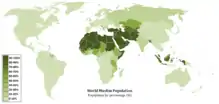Islam in the Americas
Islam is a minority religion in all of the countries and territories of the Americas, around 1% of North America population are Muslims, and 0.1% of Latin America and Caribbean population are Muslims.[1]
| Islam by country |
|---|
 |
|
|

Suriname has the highest percentage of Muslims in its population for the region, with 15.2% or 85,637 individuals, according to its 2010 census. However, the United States, in which estimates vary due to a lack of a census question, is generally believed to have the largest population, with approximately 3.45 million Muslims living there,[2] about 1.1 percent of the total U.S. population.[3]
Most Muslims in the former British Caribbean came from the Indian subcontinent as laborers following the abolition of slavery.[4] This movement also reached Suriname, although other Muslims there moved from a separate Dutch colony, which is now Indonesia. In the United States, the largest Muslim ethnic group is of African Americans, who converted in the last century, including those who converted from the actions of the syncretic, radical and revisionist group known as the Nation of Islam. However, in South America, the Muslim population is mainly composed of upper-class immigrants from the Levant, including those from Lebanon and Syria.[5]
Shias in the Americas
Shia Muslims comprise 15-20% of Muslims in the Americas.[6] Nearly 786,000 Shia Muslims are situated on United States.[7] The American Shia Muslim community are from different parts of the world such as South Asia, Europe, Middle East, and East Africa.[8][9] They have many activities and have founded several organization such as the Islamic Center of America and North America Shia Ithna-Asheri Muslim Communities Organization (NASIMCO).[10]
Population by country
The population of Muslims varies across the Americas. Below is the percentage of every American country that was Muslim in 2010, according to a Pew Research Center estimate:[11]
- Suriname - 15.2%
- Guyana - 6.4%
- Trinidad and Tobago - 5.9%
- Canada - 2.1%
- St. Vincent and the Grenadines - 1.5%
- British Virgin Islands - 1.2%
- United States - 1.1%
- Bermuda - 1.1%
- Argentina - 1.0%
- Barbados - 1.0%
- French Guiana - 0.9%
- Panama - 0.7%
- Antigua and Barbuda - 0.6%
- Cayman Islands - 0.4%
- Guadeloupe - 0.4%
- Anguilla - 0.3%
- Falkland Islands (Malvinas) - <0.1%
- Grenada - 0.3%
- St. Kitts and Nevis - 0.3%
- Venezuela - 0.3%
- Aruba - 0.2%
- Caribbean Netherlands - 0.2%
- Curaçao - 0.2%
- Martinique - 0.2%
- Sint Maarten - 0.2%
- St. Pierre and Miquelon - 0.2%
- Bahamas - 0.1%
- Belize - 0.1%
- Dominica - 0.1%
- Honduras - 0.1%
- St. Lucia - 0.1%
- U.S. Virgin Islands - 0.1%
- Bolivia - <0.1%
- Brazil - <0.1%
- Chile - <0.1%
- Colombia - <0.1%
- Costa Rica - <0.1%
- Cuba - <0.1%
- Dominican Republic - <0.1%
- Ecuador - <0.1%
- El Salvador - <0.1%
- Greenland - <0.1%
- Guatemala - <0.1%
- Haiti - <0.1%
- Jamaica - <0.1%
- Mexico - <0.1%
- Montserrat - <0.1%
- Paraguay - <0.1%
- Peru - <0.1%
- Puerto Rico - <0.1%
- Turks and Caicos Islands - <0.1%
- Uruguay - <0.1%
See also
References
- "The Global Religious Landscape" (PDF). Pewforum.org. Archived from the original (PDF) on 25 January 2017. Retrieved 7 May 2020.
- "A new estimate of U.S. Muslim population". Pew Research Center. Retrieved 2019-11-11.
- "New estimates show U.S. Muslim population continues to grow". Pew Research Center. January 3, 2018. Retrieved August 16, 2018.
- (PDF). 2011-07-27 https://web.archive.org/web/20110727173718/http://pewforum.org/uploadedfiles/Topics/Demographics/Muslimpopulation.pdf. Archived from the original (PDF) on 2011-07-27. Retrieved 2019-11-11. Missing or empty
|title=(help) - "Islam in the Caribbean". Archived from the original on 2014-09-08.
- "World Shia Muslims Population". shianumbers.com. Retrieved 19 December 2015.
- Zahid Hussain Bukhari (1 January 2004). Muslims' Place in the American Public Square: Hope, Fears, and Aspirations. Rowman Altamira. p. 37. ISBN 978-0-7591-0613-0.
- Daniel Brumberg; Dina Shehata (2009). Conflict, Identity, and Reform in the Muslim World: Challenges for U.S. Engagement. US Institute of Peace Press. pp. 366–370. ISBN 978-1-60127-020-7.
- "Mapping the Global Muslim Population". pewforum.org. 7 October 2009. Retrieved 16 December 2015.
- Mohsen Saleh (1 January 2009). American Foreign Policy and the Muslim World. Al Manhal. p. 179. ISBN 978-9953-500-65-2.
- "Religious Composition by Country, 2010-2050". Pew Research Center. 2 April 2015. Retrieved 18 August 2017.